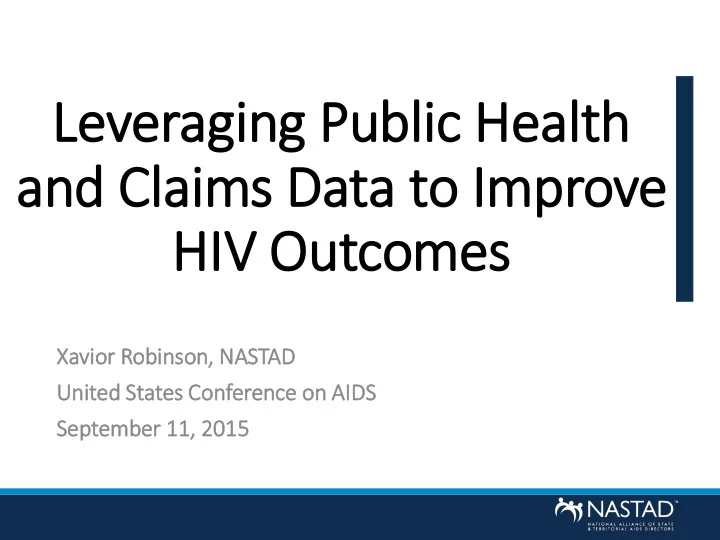

Leveraging Public Health and Claims Data to Im Improve HIV IV Outcomes Xa Xavior Robin inson, NA NASTAD Unit ited States Con onference on on AIDS Se September 11 11, , 20 2015 15
Overview National Movement to Use Data to Drive Better Health Outcomes Overview of AIDS Drug Assistance Program Data Sharing Leveraging Medicaid Claims Data to Improve HIV Services
The Movement for Actionable Data
Information without action is futile
The Public Health and Health Services Data Universe is Expansive Health Records Claims Data Public Health Data Paper Files Medicaid/Medicare Surveillance Electronic Health Private Insurance Ryan HIV/AIDS Records Companies Program Services Health Information Report All-Payer Claims Exchanges/ Regional Databases Health Information Health Departments Orgs Office of the National Coordinator (ONC)
Office of the National Coordinator Strategy
Overview of AIDS Drug Assistance Program Data Sharing
ADAP Data Sharing Goals 1) The identification of people living with HIV who are not in care 2) Linking or reengaging people who are not in care to HIV care and treatment services 3) Monitoring and improving the viral suppression and other health outcomes while people are engaged in care and treatment 4) Improve program efficiency
Data Sharing Research Methodology Objective To assess the extent to which ADAPs share client-level data NASTAD released an RFI to all programs. Fifty-one ADAPs responded between May 4 and May 30 of 2015. For the purposes of this RFI, NASTAD standardized the following definition. Definition Data sharing: The act of exchanging any client-level information with a person(s) or entity outside of your jurisdiction’s ADAP/Ryan White Part B program
Key ADAP Data Sharing Partnerships Percentage of ADAPs Sharing Client-Level Data 88% 53% 41% HIV PREVENTION HIV SURVEILLANCE MEDICAID
HIV Prevention • The most commonly shared data elements were: o care and treatment linkage information (23 or 85%); o ADAP enrollment status (15 or 56%) o age/date of birth (13 or 48%) 53% o HIV testing information (13 or 48%) o location/address information (13 or48%).
HIV Surveillance • The most commonly shared data elements were: o age/date of birth (39 or 87%) 88% o gender (36 or 80%) o CD4 count (35 or 78%) o ethnicity/race (34 or 76%) o viral load (34 or 76%) o ADAP enrollment status (32 or 71%).
Medicaid • The most commonly shared data elements were: o age/date of birth (17 or 81%) o insurance status (17 or 81%) gender (36 or 80%) o location/address information (13, or 62%) 41% o prescription fills (11 or 52%)
Sharing with Other Ryan White HIV/AIDS Program Parts • One (2%) jurisdiction has a formal data sharing agreement with a ne neig ighborin ing juri jurisdic ictio ion; 8 (16%) have an informal data sharing agreement; 42 (82%) have no data sharing agreement. • Twelve (24%) jurisdictions have a formal data sharing agreement with a Ryan an Whi hite Part art A gran antee in n the their ir juri jurisdiction; 13 (25%) have an informal data sharing agreement; 26 (51%) have no data sharing agreement. • Twelve (24%) jurisdictions have a formal data sharing agreement with a Ryan an Whi hite Part art C gran antee in n the their ir juri jurisdictio ion; 20 (39%) have an informal data sharing agreement; 19 (37%) have no data sharing agreement. • Ten (20%) jurisdictions have a formal data sharing agreement with a Ryan an Whi hite Part art D gran antee in n the their ir juri jurisdic ictio ion; 16 (31%) have an informal data sharing agreement; 25 (49%) have no data sharing agreement.
Additional Data Sharing Partners • Seven (14%) jurisdictions have a formal data sharing agreement with a state/jurisdictional department of corrections ; 10 (20%) have an informal data sharing agreement; 34 (67%) have no data sharing agreement. • Two (4%) jurisdictions have a formal data sharing agreement with a department of motor vehicles ; 0 (0%) have an informal data sharing agreement; 49 (96%) have no data sharing agreement. • One (2%) jurisdiction has a formal data sharing agreement with a department of revenue ; one (2%) has an informal data sharing agreement; 49 (96%) have no data sharing agreement. • One (2%) jurisdiction has a formal data sharing agreement with an Office of Minority Health ; 4 (8%) have an informal data sharing agreement; 46 (90%) have no data sharing agreement. • Seven (14%) jurisdictions have a formal data sharing agreement with a STD agency ; 18 (35%) have an informal data sharing agreement; 26 (51%) have no data sharing agreement.
Data Sharing Mechanisms/Authority Authority Data Sharing 10 9 8 7 6 5 4 3 2 1 0 HIV Prevention HIV Surveillance Medicaid Formal Consent Form Covered Entity
Leveraging Medicaid Claims Data to Improve HIV Services
Medicaid Claims Data Sharing is in its Infancy
Case Study: Maine • Expanded Eligibility (250% FPL) o Case management o Monitor prescription fills o Medication Adherence o Viral Suppression
Case Study: Rhode Island • Income Eligibility • Address Information • Medications Adherence • Viral Suppression • Provider Quality • Assess and Address Disparity
The Future • Improve Quality and Accountability • Assess comorbidities to tailor programming o People who use drugs o People who are living with hepatitis o People experiencing mental health conditions • Optimize allocation of resources • Address inequity • Develop a more holistic view of clients
Recommend
More recommend